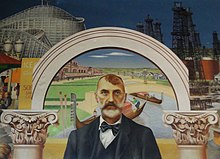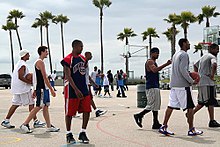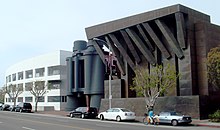Venice, Los Angeles
Venice is known for its canals, a beach, and Ocean Front Walk, a 2+1⁄2-mile (4-kilometer) pedestrian promenade that features performers, fortune-tellers, and vendors.They built a resort town on the north end of the property, called Ocean Park, which was soon annexed to Santa Monica.After the partnership dissolved in 1904, Kinney, who had won the marshy land on the south end of the property in a coin flip with his former partners, began to build a seaside resort like the namesake Italian city.[6]: 8 When Venice of America opened on July 4, 1905, Kinney had dug several miles of canals to drain the marshes for his residential area, built a 1,200-foot-long (370 m) pier with an auditorium, ship restaurant, and dance hall, constructed a hot salt-water plunge, and built a block-long arcaded business street with Venetian architecture.[citation needed] Attractions on the Kinney Pier became more amusement-oriented by 1910, when a Venice Miniature Railway, Aquarium, Virginia Reel, Whip, Racing Derby, and other rides and game booths were added.With the amusement pier burning six weeks later in December 1920, and Prohibition (which had begun the previous January), the town's tax revenue was severely affected.By 1925, with the addition of a third coaster, a tall Dragon Slide, Fun House, and Flying Circus aerial ride, it was the finest amusement pier on the West Coast.[14] By 1925, Venice's politics had become unmanageable because its roads, water and sewage systems badly needed repair and expansion to keep up with its growing population.The neighborhood lacked the automobile-centric, homogeneous character that the city sought to cultivate in the post-World War II era, and was perceived as a dated, obsolete remnant of earlier decades' land speculation.Low rents for run-down bungalows attracted predominantly European immigrants (including a substantial number of Holocaust survivors) and young counterculture artists, poets, and writers.[20] Venice Beach is one of the most difficult places in the United States to build new housing due to stringent zoning regulations.[21] The neighborhood was developed early in the history of Los Angeles, and as such much of the housing stock predates the current system of zoning regulations by decades.On the east, the boundary runs north–south on Walgrove Avenue to the neighborhood's eastern apex at Zanja Street, thus including the Penmar Golf Course but excluding Venice High School.The boundary runs on Lincoln Boulevard to Admiralty Way, excluding all of Marina del Rey, south to Ballona Creek.During the depression era, Upton Sinclair had an office there when he was running for governor, and the same historic building where the restaurant was located was also the site of the first Ace/Venice Gallery in the early 1970s.[33] The Venice Post Office, a red-tile-roofed 1939 New Deal building designed by Louis A. Simon[34] on Windward Circle, featured one of two remaining murals painted in 1941 by Modernist artist Edward Biberman.It lies 2 miles (3.2 km) away from the nearest freeway, and its unusually dense network of narrow streets was not planned for modern traffic.Venice Beach, which receives millions of visitors a year, has been labeled as "a cultural hub known for its eccentricities" as well as a "global tourist destination".This spot is sheltered on the north by an artificial barrier, the breakwater, consisting of an extending sand bar, piping, and large rocks at its end.[citation needed] In late 2010, the Los Angeles County Board of Supervisors conducted a $1.6 million replacement of 30,000 cubic yards of sand at Venice Beach eroded by rainstorms in recent years.In 2010, Aimco settled with tenants and agreed to reopen the project and return scores of evicted residents to their homes and add hundreds of units to the Venice area.[58] The 2000 U.S. census counted 37,705 residents in the 3.17-square-mile Venice neighborhood—an average of 11,891 people per square mile, about the norm for Los Angeles; in 2008, the city estimated that the population had increased to 40,885.About 22.3% of residents had been born abroad, a relatively low figure for Los Angeles; Mexico (38.4%) and the United Kingdom (8.5%) were their most common places of birth.[26] Forty-nine percent of Venice residents aged 25 and older had earned a four-year degree by 2000, a high figure for both the city and the county.Similar buildings originally formed a continuous arcade from the boardwalk to the former lagoon (now the Windward traffic circle) but these were condemned by the City of Los Angeles after annexation.[67] Constructed on a long, narrow lot in 1981, the Indiana Avenue Houses/Arnoldi Triplex was designed Frank Gehry in partnership with artists Laddie John Dill and Charles Arnoldi.[68] In 1994, sculptor Robert Graham designed a fortress-like art studio and residence for himself and his wife, actress Anjelica Huston, on Windward Avenue.Other notable artists who maintained studios in the area include Charles Arnoldi, Jean-Michel Basquiat,[70] John Baldessari, Larry Bell, Billy Al Bengston, James Georgopoulos, Dennis Hopper, and Ed Ruscha.They were restored in 2000 as part of a renovation of the beachfront park area at the end of Windward Avenue, and ever since artists have been allowed to paint there freely and legally.
















VeniceNeighborhoodCaliforniaCountyLos AngelesNamed forCity CouncilTraci ParkState SenateBen AllenState AssemblyAutumn BurkeU.S. HouseTed LieuTime zoneZIP CodesArea codesCity of Los AngelesWestside region of Los Angeles County, CaliforniaAbbot KinneyRancho La BallonaPort BallonaShip CafeSanta MonicaOcean Parknamesake Italian citymarshesship restaurantcapitalsPacific Electric RailwayVenice Miniature RailwaygondolasAbbot Kinney PierB. H. DeLayProhibitionFun HouseJames T. PeasgoodMarina PeninsulaGreat DepressionHolocaustcountercultureBeat GenerationVenice Shoreline CripsVenice 13crack cocainegentrificationLos Angeles City BeatInglewoodzoning regulationstent citiesLos Angeles International AirportSanta Monica AirportVenice High SchoolMarina del ReyBallona CreekVenice Canal Historic District72 Market Street Oyster Bar and GrillUpton SinclairAce/Venice GalleryNew DealLouis A. SimonEdward BibermanLos Angeles County Museum of Artpost office muralsJoel SilverUS Postal ServiceHollywood ReporterJack DellalStreetballersVenice Beach SkateparkVenice Fishing PierVenice Beach Boardwalkstreetballprofessional basketballsurfing3x3 basketball2028 Summer OlympicsWashington BoulevardEl NiñobreakwaterLos Angeles County Board of SupervisorsOakwood, Los AngelesMar VistaBoys and Girls ClubVenice United Methodist ChurchPenmar Parkhousing projectLincoln Place Apartment HomesHousing Authority of the City of Los AngelesLincoln Boulevardstreet sweeperssouthern Californiawarm-summer Mediterranean climateseasonal lagJune Gloomplant hardiness zoneprecipitationNon-Hispanic WhiteLatinobachelor's degreeGoogle Inc.Snap Inc.Vietnam WarMillicent Borges AccardiPhilomene LongItalian RenaissanceClaes OldenburgCoosje van BruggenBinoculars BuildingFrank GehryCharles and Ray EamesPritzker PrizeSCI-ArcThom MayneEric Owen MossMorphosisLaddie John DillCharles ArnoldiRobert GrahamAnjelica HustonChris BurdenJean-Michel BasquiatJohn BaldessariLarry BellBilly Al BengstonJames Georgopoulos


